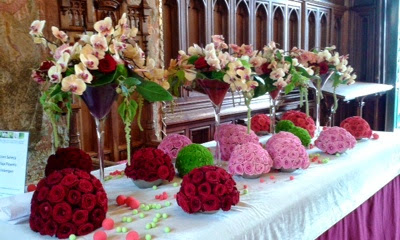By 8:30, the line was winding around the edges of the square. Since we came before breakfast, I went off to find coffee and a croissant while Terry saved our place in line. As you would expect there was a "Starbucks" on the corner of the square. This is the first Starbucks I have gone into since arriving in Europe. Determined only to drink local coffees, I succumbed only because it was the closest place open. HA.
All the flower arrangements as we passed through the City Hall were designed and arranged by a young team of flower arrangers.
THE SPECTACULAR "FLOWER CARPET"
Ok, by 9:30 am we had the required balcony photos and were free for the remainder of the day to see more of Brussels. We hopped on the get on/get off bus (different route) and headed for the Atomium and "Mini Europe", a site recommended by our friend Erin from Charlotte.
The "Atomium" is a structure which was built for the 1958 Brussels "World's Fair".
There are escalators which ascend the spokes to the attached balls, and I believe one elevaor that shoots to the top. If you see the tiny speck in some of the pictures, that is an "idiot" walking a tight rope between three balls. Fortunate for him he had on a safety line, because we watched him fall a number of times during his crossing.
We chose not to go inside the Atomium, but instead walked on to check out "Mini-Europe".
We literally walked all over Europe here. Models built on a 1:25 scale of famous or well known places found in all the countries making up the European Union, now 28 Countries.
Main seat of the Commission for the European Union. It comprises 28 Commisioners, proposed by the member States and approved by the European Parliament. The guardian of the treaties, the Commission proposes the actions or texts of laws and, after the decision of the European Union Council, monitors their proper execution.
Many of the monuments evoke fairly strong links with the 1914-1918 war. There were many we have already seen for real like Sacre-Coeur, Paris; built after the Franco-Prussian war of 1871, it was an act of piety for preventing further invasion. As an irony of history, it was opened in 1914.
Big Ben (In 1916, the lights were extinguished and its sound faint, to prevent attacks from German Zeppelins)
Met up with this fine looking soldier in London
Sevilla Spain Bull Fighting Ring
Greece and the Acropolis
and now, many more that we want to see for real.
Berlin.
Brandenburg Gate. In 1800 Napoleon took The Quadriga (chariot) back to Paris, and it was taken back by Germany after the war of 1871. The Quadriga illustrates the recurring conflicts between the two nations. Also the stage of the 1918 revolution and the Nazi marches, it was destroyed in 1945. It was to be marked by the construction of the wall in 1961 and its fall on November 9,1989, thus becoming the symbol of the democratisation of the east and Germany reunification.
Portugal
Denmark
and finally the train which takes us there "Thalys" (the high speed red train we came to Brussels on and the one we travel on most frequently)
These models were so much like the actual place that it was pretty amazing.
Even though it rained on us a bit, most of our two hour or so walk around this display was dry and enjoyable. This place is definitely worth visiting, especially informative about the European Union.





































No comments:
Post a Comment